CNA155 Health Assessment Clinical Reasoning Assignment: John Wells
VerifiedAdded on 2022/10/17
|9
|2044
|20
Report
AI Summary
This clinical reasoning assignment analyzes the case of John Wells, an 82-year-old dairy farmer who experienced a fall resulting in head trauma. The assignment follows the clinical reasoning cycle, beginning with an assessment of John's situation, considering his age, medical history (including hypertension), and the circumstances of his fall. It then details the collection of cues and information, including vital signs, and various tests like PERRLA, cognitive tests, and the Glasgow Coma Scale to assess his condition. The report processes the collected information, linking his symptoms (headache, dizziness, confusion, nausea, fatigue) to potential brain injury and his history of hypertension. The analysis considers the impact of the left hemisphere damage on cognitive function and the implications of his hypertension. The assignment references several studies to support its conclusions and provides a comprehensive understanding of the patient's condition and the application of the clinical reasoning process in a healthcare setting.
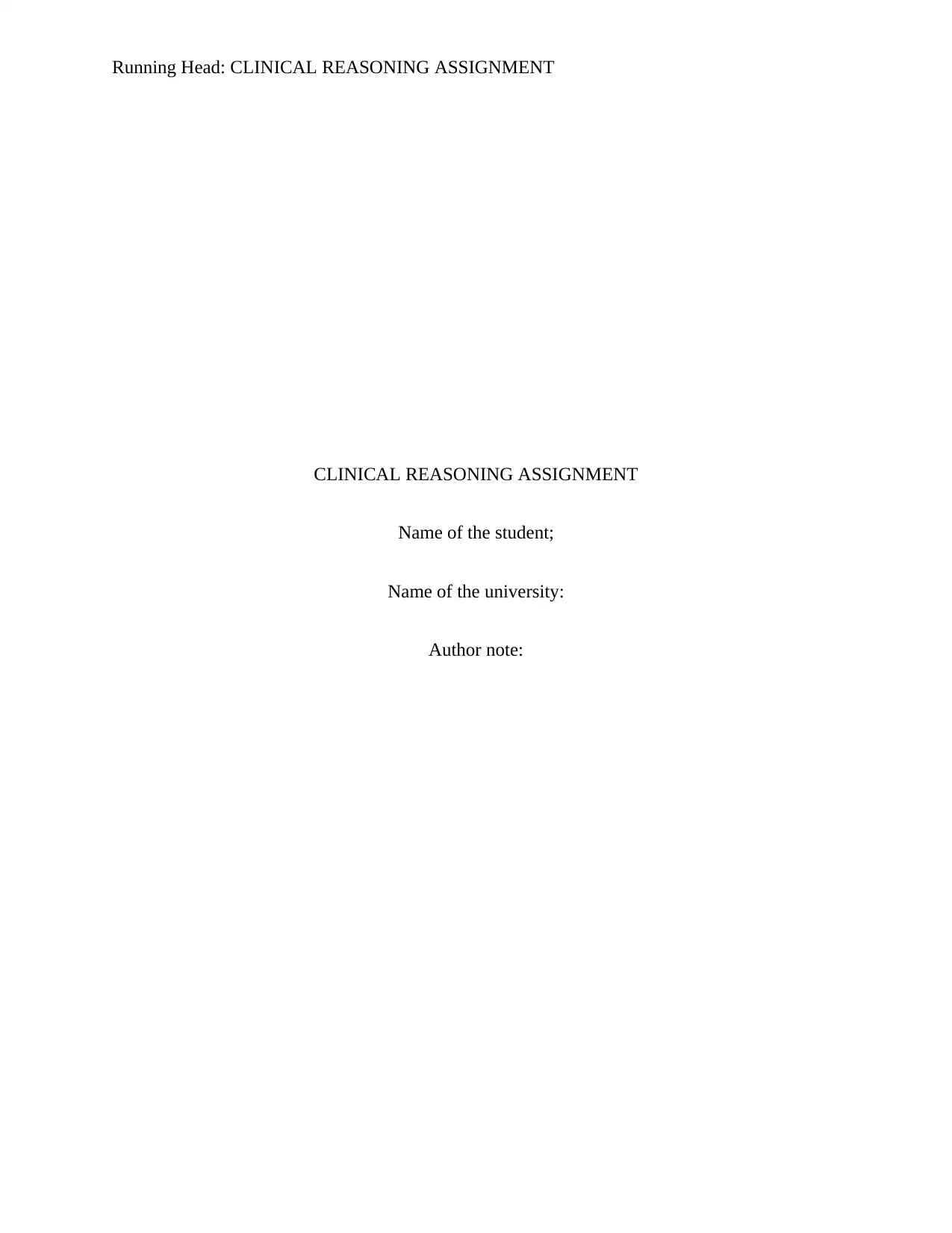
Running Head: CLINICAL REASONING ASSIGNMENT
CLINICAL REASONING ASSIGNMENT
Name of the student;
Name of the university:
Author note:
CLINICAL REASONING ASSIGNMENT
Name of the student;
Name of the university:
Author note:
Paraphrase This Document
Need a fresh take? Get an instant paraphrase of this document with our AI Paraphraser

1
CLINICAL REASONING ASSIGNMENT
Clinical reasoning cycle is considered as one of the most effective tool that is used in the
healthcare setting to analyze the patient's condition and offering according intervention (Dalton,
Gee and Levett-Jones 2015). This discussion involves at the case study of john well.
Consider the patient situation:
This section of the clinical reasoning cycle focusses on the consideration of the patient’s
situation based on their mental, physical and social well-being. Their mental, physical and social
history is considered, which either directly or indirectly have a negative impact on the health of
the patient. The patient in this case is an 82 year old man, John Wells, suffering from the primary
complications of behavioral alterations. He is a dairy farmer and lives in rural area with his wife
Mavis. While returning to home, he became unbalanced and fell hard on the by striking his left
side of the head hard on the summer ground.
After having accident, his behavior has changed, he became quiet from before, started to
lose his concentration skill and experience confusion, dizziness, headache, nausea and fatigue.
He was taken to hospital by his son Sam and after assessing the patient, it is observed that the
patient has sustained several injuries into his body that is minor skin tear in the left arm and skin
abrasion on the left forearm. After assessing the past medical history of the patient, it is observer
that patient has no past medical history of any brain injury or illness, but has clinical history of
hypertension. Instead of having the complaints of hypertension, patient stated that, he has not
been taking aby drugs for the management of high blood pressure.
As the primary complaints observed in the case of john well is immediately after the
incidents. Hence, the primary risk factor for his primary complications is supposed to be brain
injury or concussion (McKee and Daneshvar 2015).
CLINICAL REASONING ASSIGNMENT
Clinical reasoning cycle is considered as one of the most effective tool that is used in the
healthcare setting to analyze the patient's condition and offering according intervention (Dalton,
Gee and Levett-Jones 2015). This discussion involves at the case study of john well.
Consider the patient situation:
This section of the clinical reasoning cycle focusses on the consideration of the patient’s
situation based on their mental, physical and social well-being. Their mental, physical and social
history is considered, which either directly or indirectly have a negative impact on the health of
the patient. The patient in this case is an 82 year old man, John Wells, suffering from the primary
complications of behavioral alterations. He is a dairy farmer and lives in rural area with his wife
Mavis. While returning to home, he became unbalanced and fell hard on the by striking his left
side of the head hard on the summer ground.
After having accident, his behavior has changed, he became quiet from before, started to
lose his concentration skill and experience confusion, dizziness, headache, nausea and fatigue.
He was taken to hospital by his son Sam and after assessing the patient, it is observed that the
patient has sustained several injuries into his body that is minor skin tear in the left arm and skin
abrasion on the left forearm. After assessing the past medical history of the patient, it is observer
that patient has no past medical history of any brain injury or illness, but has clinical history of
hypertension. Instead of having the complaints of hypertension, patient stated that, he has not
been taking aby drugs for the management of high blood pressure.
As the primary complaints observed in the case of john well is immediately after the
incidents. Hence, the primary risk factor for his primary complications is supposed to be brain
injury or concussion (McKee and Daneshvar 2015).

2
CLINICAL REASONING ASSIGNMENT
Collection of cues and information:
After admitting john to the hospital, all the necessary information regarding the patient’s
clinical conditions is obtained. In order to for that, vital assessment is performed by the nurse. At
first the vital signs of the body such as, pulse rate, respiratory rate, body temperature, oxygen
saturation and blood pressure is obtained (Sun et al. 2018). These vital signs are assessed on the
regular basis to measure and monitor the health of the patient. The result of the vital assessment
indicates that, the recorded body temperature of the patient is 36.7 degree Celsius which is the
optimal body temperature. The observed pulse rate (81 beats per minute) and the respiratory rate
(17 breaths per minute) of the patient are also within the normal rang. During the patient
assessment, oxygen saturation of the patient is also evaluated which is observed to be above 95%
(optimal oxygen saturation). The recorded blood pressure is 148/84, which is high than the
normal body pressure (120/80) Hence, from the vital signs assessment it is clearly evident that
except the blood pressure, all the other vitals of the patient is optimal and within the normal
range. (Staessen et al. 2017).
After assessing the vitals of the patient, information regarding the subject data such as
experienced symptoms is collected from the patient. From that it is observed that the symptoms
observed in the case of patient are hazy, fatigue, headache, dizziness, loss of appetite, confusion
and headache.
To gather more information about the signs and symptoms of health condition, different
tests such as, PERRLA test, cognitive test, glasses coma scale test and confusion test should be
conducted by the nurse.
CLINICAL REASONING ASSIGNMENT
Collection of cues and information:
After admitting john to the hospital, all the necessary information regarding the patient’s
clinical conditions is obtained. In order to for that, vital assessment is performed by the nurse. At
first the vital signs of the body such as, pulse rate, respiratory rate, body temperature, oxygen
saturation and blood pressure is obtained (Sun et al. 2018). These vital signs are assessed on the
regular basis to measure and monitor the health of the patient. The result of the vital assessment
indicates that, the recorded body temperature of the patient is 36.7 degree Celsius which is the
optimal body temperature. The observed pulse rate (81 beats per minute) and the respiratory rate
(17 breaths per minute) of the patient are also within the normal rang. During the patient
assessment, oxygen saturation of the patient is also evaluated which is observed to be above 95%
(optimal oxygen saturation). The recorded blood pressure is 148/84, which is high than the
normal body pressure (120/80) Hence, from the vital signs assessment it is clearly evident that
except the blood pressure, all the other vitals of the patient is optimal and within the normal
range. (Staessen et al. 2017).
After assessing the vitals of the patient, information regarding the subject data such as
experienced symptoms is collected from the patient. From that it is observed that the symptoms
observed in the case of patient are hazy, fatigue, headache, dizziness, loss of appetite, confusion
and headache.
To gather more information about the signs and symptoms of health condition, different
tests such as, PERRLA test, cognitive test, glasses coma scale test and confusion test should be
conducted by the nurse.
⊘ This is a preview!⊘
Do you want full access?
Subscribe today to unlock all pages.

Trusted by 1+ million students worldwide

3
CLINICAL REASONING ASSIGNMENT
In the glass coma scale, the motor response and coordination of the patient is assessed.
The glass coma scale is used to analyze the Verbal and motor response of the patient in the
patient having brain illness. After assessing the patient, score is assigned to the patient. If the
score is below 8, patient have low conscious level and if it is high than 13, high conscious level
is supposed and if in between, mild consciousness (Dubey and Kumar 2019).
Along with this other test such as, PERRLA is performed to evaluate if the patient has
any other brain illness. The patent recently had an accident, where the left hemisphere of the
brain got hit by the ground. Therefore, it is important for the nurse to conduct an assessment to
evaluate if the patient ah sustained any cranial injury. In the PERRLA test, the dilation of the
pupil is observed to assess the brain condition.
Cognitive test is also conducted to evaluate the cognitive functioning of the patient. By
observing the mental and physical symptoms of the patient, it can be assumed that the patient is
undergoing cognitive disability, which can be assessed by the aid of cognitive test. As the patient
has met an accident and has pain, the pain assessment test has also been conducted and score is
recorded based on that (Kamat and Rathi 2019) The pain score of the patient is recorded as 4/10,
which means that the patient is having moderate pain (Mercadante et al. 2015).
Processing the information:
The information gathered in the previous step is processed and analyzed in this step.
The major complaints that can be responsible for the patient signs and symptoms
mentioned above is previous clinical data of hypertension and brain injury during accident.
CLINICAL REASONING ASSIGNMENT
In the glass coma scale, the motor response and coordination of the patient is assessed.
The glass coma scale is used to analyze the Verbal and motor response of the patient in the
patient having brain illness. After assessing the patient, score is assigned to the patient. If the
score is below 8, patient have low conscious level and if it is high than 13, high conscious level
is supposed and if in between, mild consciousness (Dubey and Kumar 2019).
Along with this other test such as, PERRLA is performed to evaluate if the patient has
any other brain illness. The patent recently had an accident, where the left hemisphere of the
brain got hit by the ground. Therefore, it is important for the nurse to conduct an assessment to
evaluate if the patient ah sustained any cranial injury. In the PERRLA test, the dilation of the
pupil is observed to assess the brain condition.
Cognitive test is also conducted to evaluate the cognitive functioning of the patient. By
observing the mental and physical symptoms of the patient, it can be assumed that the patient is
undergoing cognitive disability, which can be assessed by the aid of cognitive test. As the patient
has met an accident and has pain, the pain assessment test has also been conducted and score is
recorded based on that (Kamat and Rathi 2019) The pain score of the patient is recorded as 4/10,
which means that the patient is having moderate pain (Mercadante et al. 2015).
Processing the information:
The information gathered in the previous step is processed and analyzed in this step.
The major complaints that can be responsible for the patient signs and symptoms
mentioned above is previous clinical data of hypertension and brain injury during accident.
Paraphrase This Document
Need a fresh take? Get an instant paraphrase of this document with our AI Paraphraser
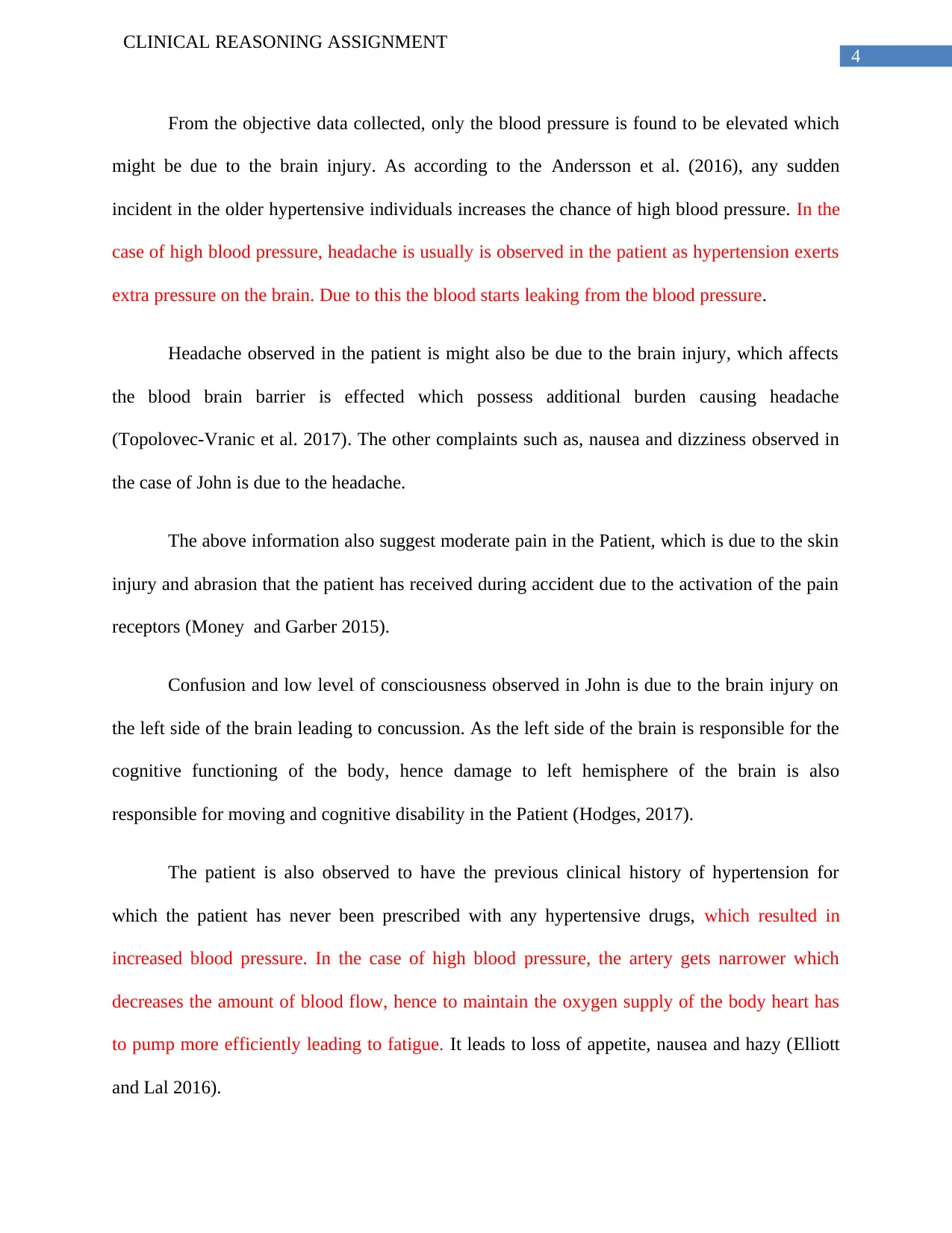
4
CLINICAL REASONING ASSIGNMENT
From the objective data collected, only the blood pressure is found to be elevated which
might be due to the brain injury. As according to the Andersson et al. (2016), any sudden
incident in the older hypertensive individuals increases the chance of high blood pressure. In the
case of high blood pressure, headache is usually is observed in the patient as hypertension exerts
extra pressure on the brain. Due to this the blood starts leaking from the blood pressure.
Headache observed in the patient is might also be due to the brain injury, which affects
the blood brain barrier is effected which possess additional burden causing headache
(Topolovec-Vranic et al. 2017). The other complaints such as, nausea and dizziness observed in
the case of John is due to the headache.
The above information also suggest moderate pain in the Patient, which is due to the skin
injury and abrasion that the patient has received during accident due to the activation of the pain
receptors (Money and Garber 2015).
Confusion and low level of consciousness observed in John is due to the brain injury on
the left side of the brain leading to concussion. As the left side of the brain is responsible for the
cognitive functioning of the body, hence damage to left hemisphere of the brain is also
responsible for moving and cognitive disability in the Patient (Hodges, 2017).
The patient is also observed to have the previous clinical history of hypertension for
which the patient has never been prescribed with any hypertensive drugs, which resulted in
increased blood pressure. In the case of high blood pressure, the artery gets narrower which
decreases the amount of blood flow, hence to maintain the oxygen supply of the body heart has
to pump more efficiently leading to fatigue. It leads to loss of appetite, nausea and hazy (Elliott
and Lal 2016).
CLINICAL REASONING ASSIGNMENT
From the objective data collected, only the blood pressure is found to be elevated which
might be due to the brain injury. As according to the Andersson et al. (2016), any sudden
incident in the older hypertensive individuals increases the chance of high blood pressure. In the
case of high blood pressure, headache is usually is observed in the patient as hypertension exerts
extra pressure on the brain. Due to this the blood starts leaking from the blood pressure.
Headache observed in the patient is might also be due to the brain injury, which affects
the blood brain barrier is effected which possess additional burden causing headache
(Topolovec-Vranic et al. 2017). The other complaints such as, nausea and dizziness observed in
the case of John is due to the headache.
The above information also suggest moderate pain in the Patient, which is due to the skin
injury and abrasion that the patient has received during accident due to the activation of the pain
receptors (Money and Garber 2015).
Confusion and low level of consciousness observed in John is due to the brain injury on
the left side of the brain leading to concussion. As the left side of the brain is responsible for the
cognitive functioning of the body, hence damage to left hemisphere of the brain is also
responsible for moving and cognitive disability in the Patient (Hodges, 2017).
The patient is also observed to have the previous clinical history of hypertension for
which the patient has never been prescribed with any hypertensive drugs, which resulted in
increased blood pressure. In the case of high blood pressure, the artery gets narrower which
decreases the amount of blood flow, hence to maintain the oxygen supply of the body heart has
to pump more efficiently leading to fatigue. It leads to loss of appetite, nausea and hazy (Elliott
and Lal 2016).
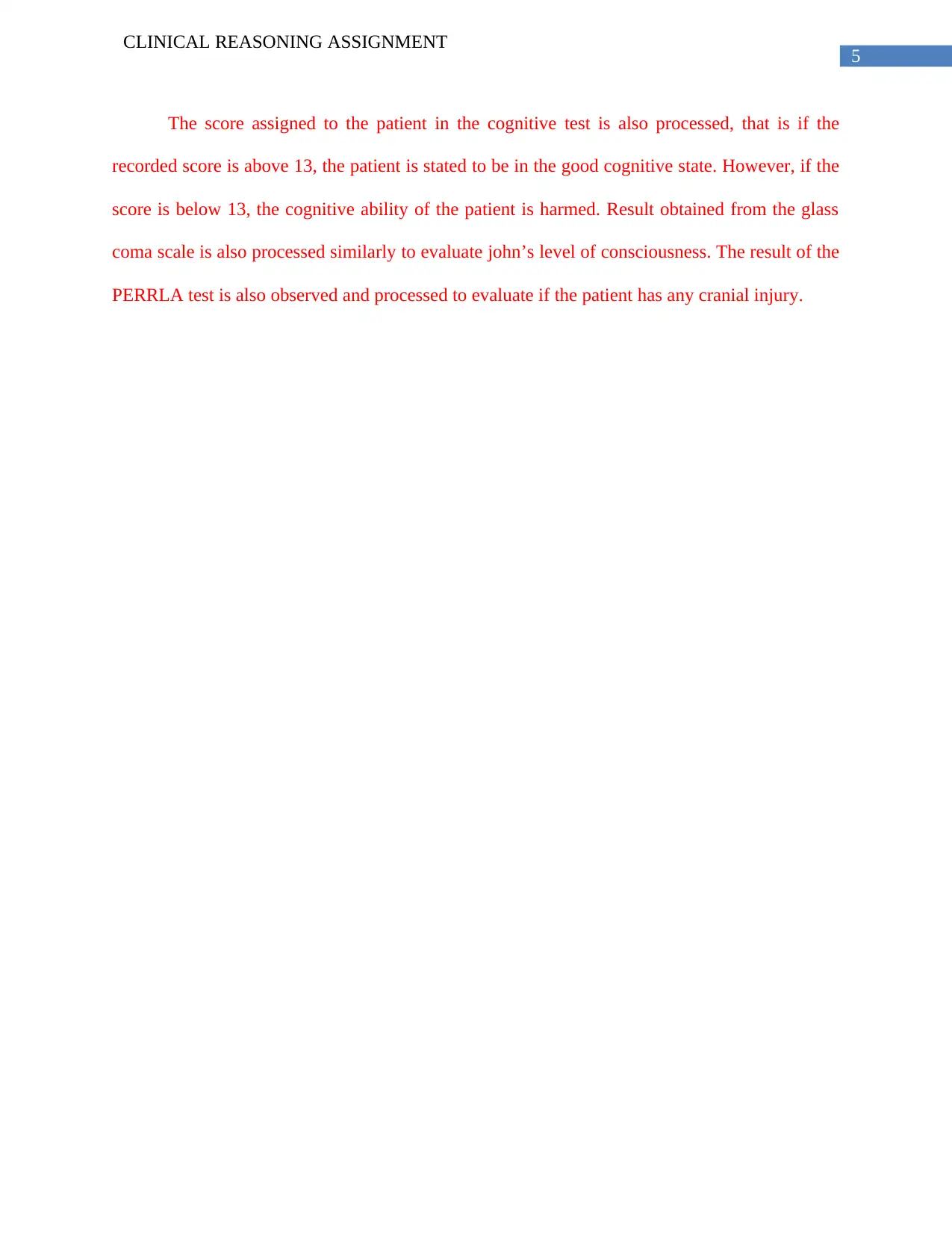
5
CLINICAL REASONING ASSIGNMENT
The score assigned to the patient in the cognitive test is also processed, that is if the
recorded score is above 13, the patient is stated to be in the good cognitive state. However, if the
score is below 13, the cognitive ability of the patient is harmed. Result obtained from the glass
coma scale is also processed similarly to evaluate john’s level of consciousness. The result of the
PERRLA test is also observed and processed to evaluate if the patient has any cranial injury.
CLINICAL REASONING ASSIGNMENT
The score assigned to the patient in the cognitive test is also processed, that is if the
recorded score is above 13, the patient is stated to be in the good cognitive state. However, if the
score is below 13, the cognitive ability of the patient is harmed. Result obtained from the glass
coma scale is also processed similarly to evaluate john’s level of consciousness. The result of the
PERRLA test is also observed and processed to evaluate if the patient has any cranial injury.
⊘ This is a preview!⊘
Do you want full access?
Subscribe today to unlock all pages.

Trusted by 1+ million students worldwide
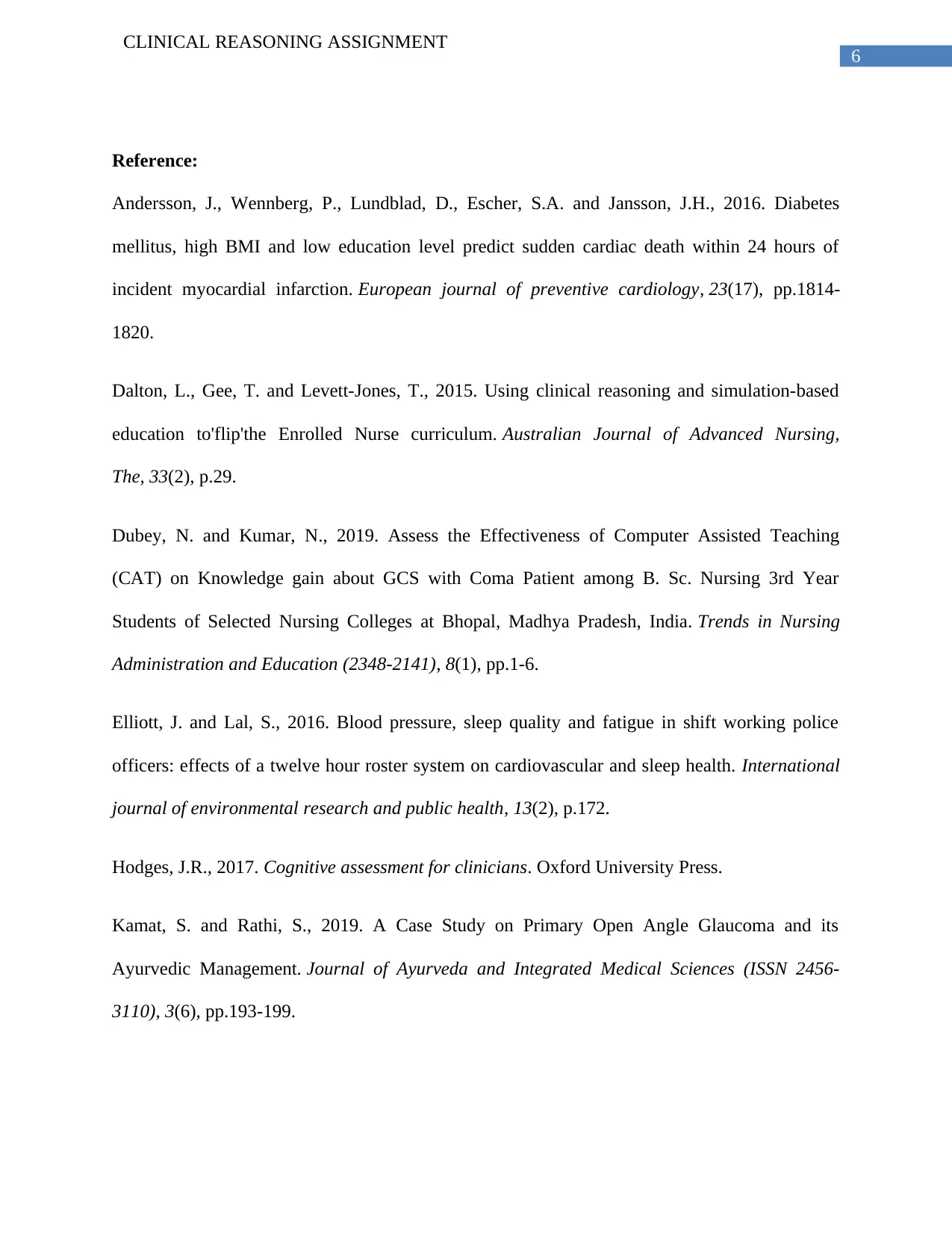
6
CLINICAL REASONING ASSIGNMENT
Reference:
Andersson, J., Wennberg, P., Lundblad, D., Escher, S.A. and Jansson, J.H., 2016. Diabetes
mellitus, high BMI and low education level predict sudden cardiac death within 24 hours of
incident myocardial infarction. European journal of preventive cardiology, 23(17), pp.1814-
1820.
Dalton, L., Gee, T. and Levett-Jones, T., 2015. Using clinical reasoning and simulation-based
education to'flip'the Enrolled Nurse curriculum. Australian Journal of Advanced Nursing,
The, 33(2), p.29.
Dubey, N. and Kumar, N., 2019. Assess the Effectiveness of Computer Assisted Teaching
(CAT) on Knowledge gain about GCS with Coma Patient among B. Sc. Nursing 3rd Year
Students of Selected Nursing Colleges at Bhopal, Madhya Pradesh, India. Trends in Nursing
Administration and Education (2348-2141), 8(1), pp.1-6.
Elliott, J. and Lal, S., 2016. Blood pressure, sleep quality and fatigue in shift working police
officers: effects of a twelve hour roster system on cardiovascular and sleep health. International
journal of environmental research and public health, 13(2), p.172.
Hodges, J.R., 2017. Cognitive assessment for clinicians. Oxford University Press.
Kamat, S. and Rathi, S., 2019. A Case Study on Primary Open Angle Glaucoma and its
Ayurvedic Management. Journal of Ayurveda and Integrated Medical Sciences (ISSN 2456-
3110), 3(6), pp.193-199.
CLINICAL REASONING ASSIGNMENT
Reference:
Andersson, J., Wennberg, P., Lundblad, D., Escher, S.A. and Jansson, J.H., 2016. Diabetes
mellitus, high BMI and low education level predict sudden cardiac death within 24 hours of
incident myocardial infarction. European journal of preventive cardiology, 23(17), pp.1814-
1820.
Dalton, L., Gee, T. and Levett-Jones, T., 2015. Using clinical reasoning and simulation-based
education to'flip'the Enrolled Nurse curriculum. Australian Journal of Advanced Nursing,
The, 33(2), p.29.
Dubey, N. and Kumar, N., 2019. Assess the Effectiveness of Computer Assisted Teaching
(CAT) on Knowledge gain about GCS with Coma Patient among B. Sc. Nursing 3rd Year
Students of Selected Nursing Colleges at Bhopal, Madhya Pradesh, India. Trends in Nursing
Administration and Education (2348-2141), 8(1), pp.1-6.
Elliott, J. and Lal, S., 2016. Blood pressure, sleep quality and fatigue in shift working police
officers: effects of a twelve hour roster system on cardiovascular and sleep health. International
journal of environmental research and public health, 13(2), p.172.
Hodges, J.R., 2017. Cognitive assessment for clinicians. Oxford University Press.
Kamat, S. and Rathi, S., 2019. A Case Study on Primary Open Angle Glaucoma and its
Ayurvedic Management. Journal of Ayurveda and Integrated Medical Sciences (ISSN 2456-
3110), 3(6), pp.193-199.
Paraphrase This Document
Need a fresh take? Get an instant paraphrase of this document with our AI Paraphraser
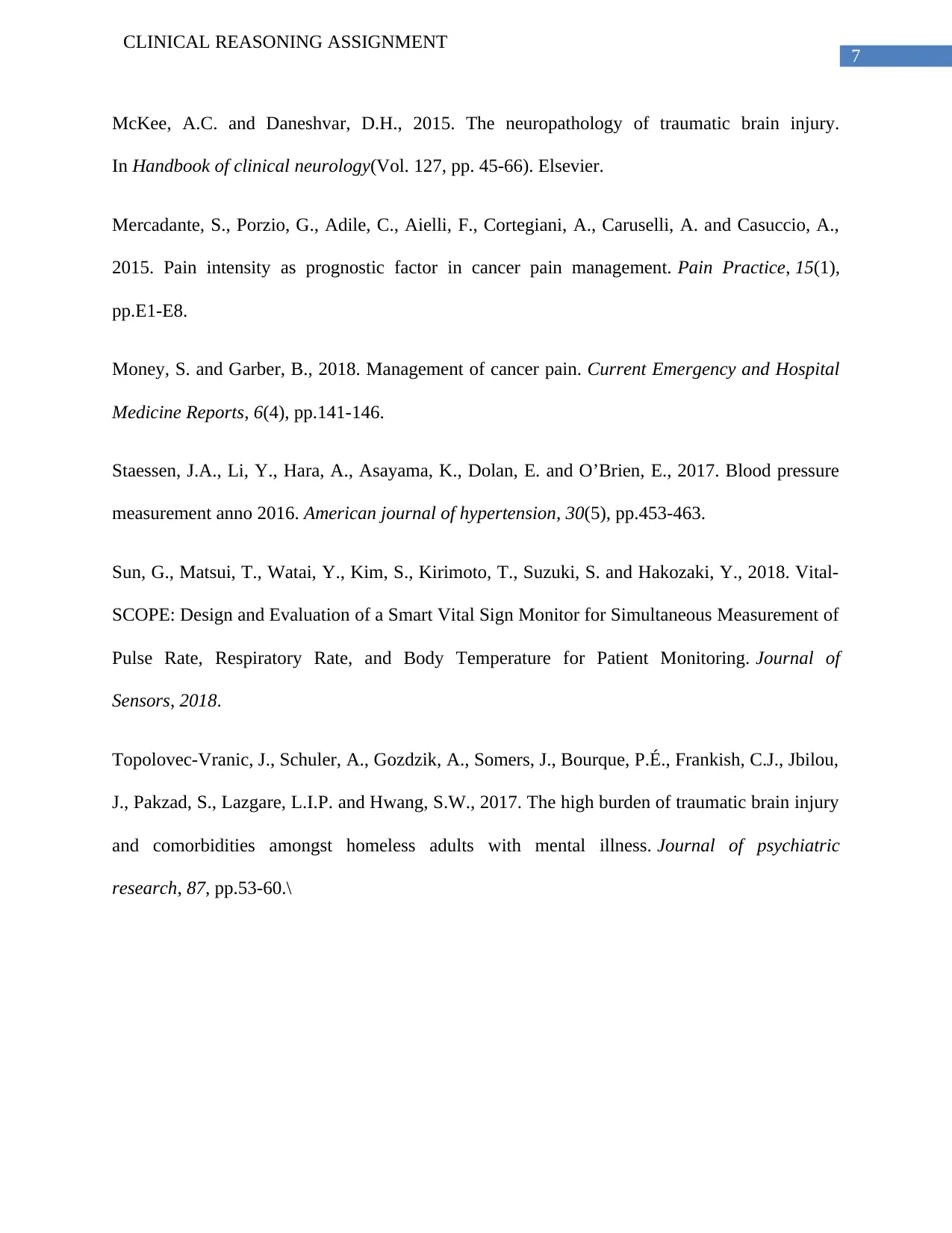
7
CLINICAL REASONING ASSIGNMENT
McKee, A.C. and Daneshvar, D.H., 2015. The neuropathology of traumatic brain injury.
In Handbook of clinical neurology(Vol. 127, pp. 45-66). Elsevier.
Mercadante, S., Porzio, G., Adile, C., Aielli, F., Cortegiani, A., Caruselli, A. and Casuccio, A.,
2015. Pain intensity as prognostic factor in cancer pain management. Pain Practice, 15(1),
pp.E1-E8.
Money, S. and Garber, B., 2018. Management of cancer pain. Current Emergency and Hospital
Medicine Reports, 6(4), pp.141-146.
Staessen, J.A., Li, Y., Hara, A., Asayama, K., Dolan, E. and O’Brien, E., 2017. Blood pressure
measurement anno 2016. American journal of hypertension, 30(5), pp.453-463.
Sun, G., Matsui, T., Watai, Y., Kim, S., Kirimoto, T., Suzuki, S. and Hakozaki, Y., 2018. Vital-
SCOPE: Design and Evaluation of a Smart Vital Sign Monitor for Simultaneous Measurement of
Pulse Rate, Respiratory Rate, and Body Temperature for Patient Monitoring. Journal of
Sensors, 2018.
Topolovec-Vranic, J., Schuler, A., Gozdzik, A., Somers, J., Bourque, P.É., Frankish, C.J., Jbilou,
J., Pakzad, S., Lazgare, L.I.P. and Hwang, S.W., 2017. The high burden of traumatic brain injury
and comorbidities amongst homeless adults with mental illness. Journal of psychiatric
research, 87, pp.53-60.\
CLINICAL REASONING ASSIGNMENT
McKee, A.C. and Daneshvar, D.H., 2015. The neuropathology of traumatic brain injury.
In Handbook of clinical neurology(Vol. 127, pp. 45-66). Elsevier.
Mercadante, S., Porzio, G., Adile, C., Aielli, F., Cortegiani, A., Caruselli, A. and Casuccio, A.,
2015. Pain intensity as prognostic factor in cancer pain management. Pain Practice, 15(1),
pp.E1-E8.
Money, S. and Garber, B., 2018. Management of cancer pain. Current Emergency and Hospital
Medicine Reports, 6(4), pp.141-146.
Staessen, J.A., Li, Y., Hara, A., Asayama, K., Dolan, E. and O’Brien, E., 2017. Blood pressure
measurement anno 2016. American journal of hypertension, 30(5), pp.453-463.
Sun, G., Matsui, T., Watai, Y., Kim, S., Kirimoto, T., Suzuki, S. and Hakozaki, Y., 2018. Vital-
SCOPE: Design and Evaluation of a Smart Vital Sign Monitor for Simultaneous Measurement of
Pulse Rate, Respiratory Rate, and Body Temperature for Patient Monitoring. Journal of
Sensors, 2018.
Topolovec-Vranic, J., Schuler, A., Gozdzik, A., Somers, J., Bourque, P.É., Frankish, C.J., Jbilou,
J., Pakzad, S., Lazgare, L.I.P. and Hwang, S.W., 2017. The high burden of traumatic brain injury
and comorbidities amongst homeless adults with mental illness. Journal of psychiatric
research, 87, pp.53-60.\
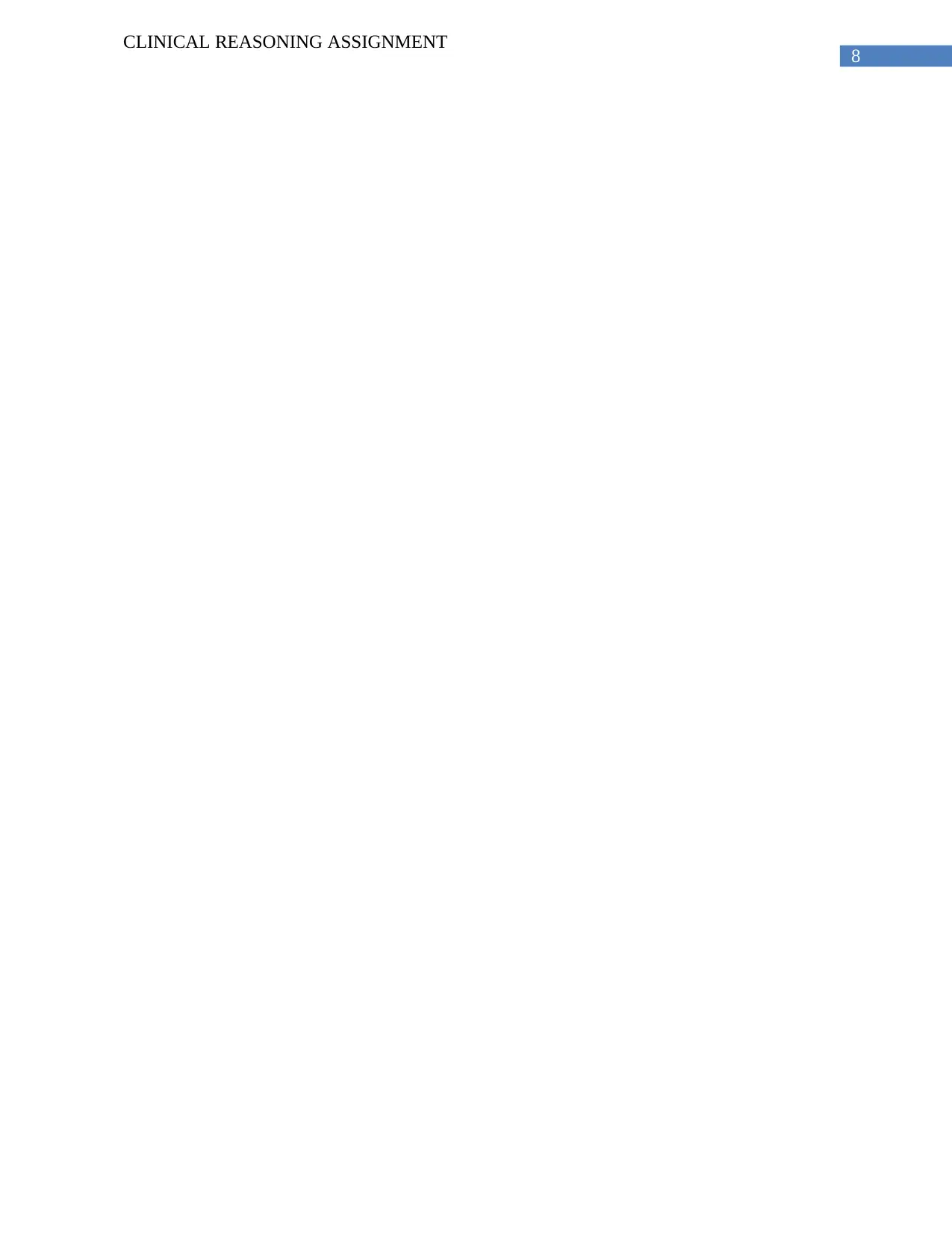
8
CLINICAL REASONING ASSIGNMENT
CLINICAL REASONING ASSIGNMENT
⊘ This is a preview!⊘
Do you want full access?
Subscribe today to unlock all pages.

Trusted by 1+ million students worldwide
1 out of 9
Related Documents
Your All-in-One AI-Powered Toolkit for Academic Success.
+13062052269
info@desklib.com
Available 24*7 on WhatsApp / Email
![[object Object]](/_next/static/media/star-bottom.7253800d.svg)
Unlock your academic potential
Copyright © 2020–2025 A2Z Services. All Rights Reserved. Developed and managed by ZUCOL.





